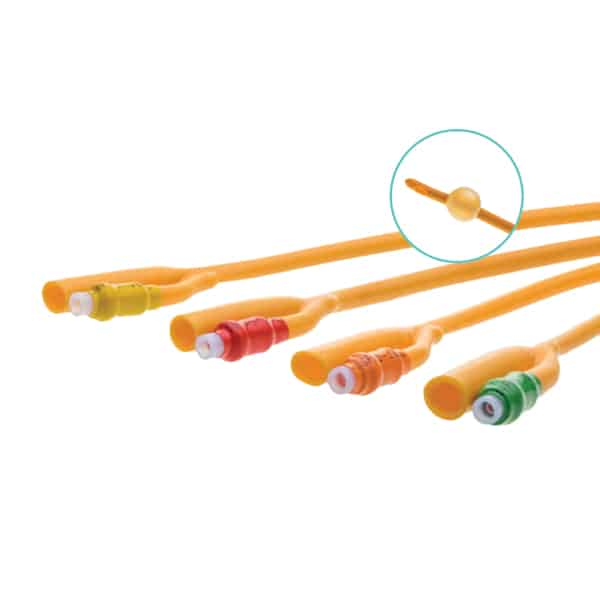In the field of urology, the Foley catheter stands out as a pivotal medical device designed for urinary drainage. Named after its inventor, Frederic Foley, this catheter is distinguished by its dual-lumen design, facilitating both urine drainage into a collection system and the securement of the catheter in place via an inflatable balloon. Originally conceptualized in 1929, the Foley catheter’s utility lies in its ability to remain within the bladder for extended periods, thereby aiding patients who require long-term urinary management. The device’s construction from materials like silicone or latex, often enhanced with coatings for biocompatibility and durability, underscores its evolution to meet diverse clinical needs.
Historical Perspective and Design
The genesis of the Foley catheter dates back to the 1930s, when Frederic Foley, a Boston-based surgeon, introduced his design. This innovation was subsequently adopted and mass-produced by C.R. Bard, Inc., setting a precedent for urinary catheterization technology. Today, a multitude of manufacturers globally contribute to the variety available, incorporating materials ranging from silicone to latex, in response to both medical requirements and patient allergies. Despite the advent of modern materials, the preference for traditional glass catheters persists among a niche of long-term users, highlighting the balance between innovation and individual patient preference.
Classification and Types of Foley Catheters
Foley catheters are categorized based on their physical characteristics and functional designs. The indwelling types, known for their dual-channel configuration, enable both urine collection and balloon inflation. Specialized versions include the Coudé catheter, designed with a tip curvature to navigate enlarged prostates, and the triple-lumen catheter, employed postoperatively for bladder irrigation. The diversity in catheter types underscores the importance of personalized medical care, tailoring catheter selection to the unique anatomical and surgical needs of each patient.
Indications and Medical Applications
Foley catheters serve a broad spectrum of clinical indications, from facilitating urine drainage in patients with acute urinary retention to supporting those undergoing surgical procedures. Their utility extends beyond urology, aiding in cervical dilation during labor induction and managing severe epistaxis. However, their application is governed by stringent clinical criteria to minimize the risk of catheter-associated urinary tract infections and other potential complications.
Risks and Management of Adverse Effects
Despite their clinical indispensability, Foley catheters are associated with risks, notably catheter-associated urinary tract infections and mechanical complications during insertion or maintenance. The industry’s shift towards silver-coated catheters reflects ongoing efforts to mitigate infection risks. Proper catheter selection, meticulous insertion techniques, and vigilant maintenance are crucial to minimizing adverse effects, ensuring patient safety, and enhancing the therapeutic outcomes of catheterization.
Key Considerations for Foley Catheter Selection
When selecting a Foley catheter, several critical factors must be considered to ensure optimal patient comfort and efficacy of the catheterization process:
- Material Composition: Silicone vs. Latex vs. Silicone-Coated Latex;
- Catheter Size: Determined by the French scale, with sizes varying for pediatric to adult patients;
- Coating Type: Hydrogel, Polytetrafluoroethylene (PTFE), or Silicone Elastomer;
- Balloon Capacity: Typically ranges from 5cc to 30cc, affecting the catheter’s stability within the bladder;
- Lumen Configuration: Single, Double, or Triple lumen designs for different clinical applications.
Comparative Table: Foley Catheter Features by Type
| Feature | Silicone | Latex | Silicone-Coated Latex |
|---|---|---|---|
| Biocompatibility | High | Moderate | Enhanced |
| Durability | Up to 3 months | Up to 4 weeks | Up to 4 weeks |
| Risk of Allergy | Low | High | Moderate |
| Surface Coating Options | Hydrogel, PTFE | Limited | Hydrogel, PTFE |
| Indwelling Duration | Preferred for long-term use | Short-term use | Short-term use |
Evolving Technologies in Catheter Design
The advancement of Foley catheter technology reflects a commitment to improving patient care through innovation. In recent years, the focus has shifted towards materials that reduce the risk of infection and enhance comfort during prolonged use. For instance, the development of silver-coated catheters represents a leap forward in preventing catheter-associated urinary tract infections.
Additionally, the exploration of novel coatings such as antimicrobial peptides and nanotechnology-based surfaces offers promising avenues for reducing biofilm formation and improving catheter longevity. These technological evolutions not only promise to elevate the standard of care but also aim to expand the therapeutic potential of Foley catheters in various medical disciplines.
Best Practices in Catheter Management
Effective management of indwelling catheters is paramount to preventing complications and ensuring patient well-being. Key practices include stringent adherence to aseptic insertion techniques to minimize infection risks and regular monitoring of catheter function to prevent blockages and ensure efficient urine drainage.
Education on catheter care for both healthcare professionals and patients plays a crucial role in identifying and addressing issues promptly. Furthermore, adopting a patient-centered approach that considers the individual’s lifestyle, preferences, and potential sensitivities is essential for optimizing the catheterization experience and outcome.
Future Directions in Urinary Catheterization
The landscape of urinary catheterization is poised for transformative changes, driven by ongoing research and patient feedback. Future directions include the development of smarter catheters equipped with sensors for real-time monitoring of infection markers or urine output, thereby enabling early intervention and personalized care strategies.
Moreover, the exploration of biodegradable materials could revolutionize long-term catheterization by reducing the need for frequent changes and minimizing environmental impact. Collaborative efforts among clinicians, researchers, and industry stakeholders are crucial to advancing these innovations from concept to clinical practice, heralding a new era in the management of urinary retention and related conditions.
Conclusion
As we stand on the cusp of medical innovation, the future of Foley catheterization promises unprecedented improvements in patient care, safety, and comfort. The continuous evolution of catheter materials, designs, and coatings is a testament to the medical community’s commitment to addressing the complex needs of patients requiring urinary management. With the advent of advanced technologies, including antimicrobial coatings and smart catheters, we are moving towards a new horizon where urinary catheterization not only becomes more efficient but also significantly safer, with reduced risks of infection and enhanced patient comfort.
Moreover, the focus on patient-centered care, emphasizing education, proper management, and personalized treatment plans, is crucial for optimizing outcomes and enhancing the quality of life for those dependent on these vital medical devices. As research progresses and new materials and technologies emerge, the collaboration among healthcare professionals, researchers, and patients will be pivotal in shaping the future of Foley catheterization—a future where complications are minimized, and patient dignity and comfort are placed at the forefront of care.



